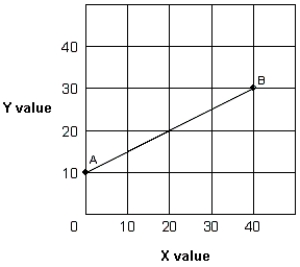A) the model includes all important variables occurring in the real world.
B) all factors which influence the event are changing at the same time.
C) one influence is changing and everything else is being held constant.
D) the consumer is king.
F) A) and C)
Correct Answer

verified
Correct Answer
verified
Multiple Choice
Which of the following would eliminate scarcity as an economic problem?
A) Moderation of people's competitive instincts.
B) Discovery of sufficiently large new energy reserves.
C) Resumption of steady productivity growth.
D) None of these.
F) C) and D)
Correct Answer

verified
Correct Answer
verified
Multiple Choice
Scarcity is a problem:
A) measured by the amount of goods available.
B) of the poor, but not the rich.
C) because human wants are unlimited while resources are limited.
D) only in industrialized economies.
F) All of the above
Correct Answer

verified
Correct Answer
verified
True/False
The observation that interest rates are higher in years ending with a 1 or a 6 represents causality rather than association.
B) False
Correct Answer

verified
Correct Answer
verified
Multiple Choice
Which of the following is not an example of a capital input?
A) A person's skills and abilities, which can be employed to produce valuable goods and services.
B) Factories and offices where goods and services are produced.
C) Tools and equipment.
D) Computers used by a company to record inventory, sales, and payroll.
F) All of the above
Correct Answer

verified
Correct Answer
verified
Multiple Choice
The branch of economics that focuses on economywide variables like inflation and unemployment is called:
A) macroeconomics.
B) microeconomics.
C) free-market economics.
D) aggregate economics.
F) A) and B)
Correct Answer

verified
Correct Answer
verified
True/False
If two variables are inversely related, then they change in the same direction.
B) False
Correct Answer

verified
Correct Answer
verified
Multiple Choice
Positive economics is a(n) :
A) reflection of a country's values.
B) judgment of the correctness of an economic outcome.
C) statement of fact.
D) analysis of what ought to be.
E) analysis of all the good market outcomes.
G) A) and B)
Correct Answer

verified
Correct Answer
verified
Multiple Choice
To be valid, an economic model must:
A) include every activity which occurs in the real world.
B) include at least 85 percent of the activity which occurs in the real world.
C) be able to predict events occurring in the real world.
D) exclude any link to the real world.
E) not be based on an abstraction of the real world.
G) All of the above
Correct Answer

verified
Correct Answer
verified
Multiple Choice
A factor of production is the same as:
A) the amount of a good produced.
B) the price of a good.
C) a profit of a firm.
D) an opportunity cost.
E) a resource.
G) C) and E)
Correct Answer

verified
Correct Answer
verified
Multiple Choice
The study of microeconomics and macroeconomics differ in that:
A) microeconomics is concerned with the domestic economy and macroeconomics is concerned only with the international economy.
B) microeconomics examines the individual markets of the economy while macroeconomics studies the whole economy.
C) microeconomics studies the actions of households and macroeconomics studies the actions of business firms.
D) microeconomics examines the whole economy while macroeconomics studies the individual units of the economy.
F) A) and B)
Correct Answer

verified
Correct Answer
verified
True/False
Capital resources include money and other financial assets.
B) False
Correct Answer

verified
Correct Answer
verified
Multiple Choice
When economists say scarcity, they mean:
A) there are only a limited number of consumers who would be interested in purchasing goods.
B) the human desire for goods exceeds the available supply of time, goods and resources.
C) most people in poorer countries do not have enough goods.
D) goods are so expensive that only the rich can afford it.
F) A) and C)
Correct Answer

verified
Correct Answer
verified
Multiple Choice
Which of the following is included in the study of macroeconomics?
A) Salaries of college professors.
B) Computer prices.
C) Unemployment in the nation.
D) Silver prices.
F) A) and D)
Correct Answer

verified
Correct Answer
verified
Multiple Choice
Select the normative statement that completes the following sentence: If the minimum wage is raised:
A) cost per unit of output will rise.
B) workers will gain their rightful share of total income.
C) the rate of inflation will increase.
D) profits will fall.
F) A) and B)
Correct Answer

verified
Correct Answer
verified
Multiple Choice
Which of the following is not a factor of production?
A) A computer chip.
B) The service of a lawyer.
C) Dollars.
D) All of these are factors of production.
F) B) and D)
Correct Answer

verified
Correct Answer
verified
Multiple Choice
Exhibit 1A-1 Straight line
 -Straight line AB in Exhibit 1A-1 shows that:
-Straight line AB in Exhibit 1A-1 shows that:
A) increasing values for X will decrease the values of Y.
B) decreasing values for X will increase the values of Y.
C) there is a direct relationship between X and Y.
D) all of these.
F) C) and D)
Correct Answer

verified
Correct Answer
verified
True/False
Scarcity has no importance to understanding economics.
B) False
Correct Answer

verified
Correct Answer
verified
Multiple Choice
The Latin expression Ceteris paribus means:
A) everything else being equal.
B) economic model.
C) economists are partly right.
D) partial scarcity is certain.
F) None of the above
Correct Answer

verified
Correct Answer
verified
Multiple Choice
The basic purpose of economic models is to:
A) construct simplifying assumptions about the real world.
B) explain reality in all its complexity.
C) construct situations where controlled experiments can be carried out.
D) provide explanations for, and predictions of the relationship between variables.
F) None of the above
Correct Answer

verified
Correct Answer
verified
Showing 81 - 100 of 251
Related Exams